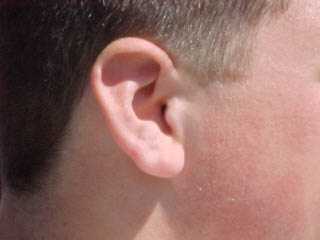PTC
Tasting: Phenylthiocarbamide (PTC) is human-made chemical
that is similar to a naturally occurring substance found in turnip
greens, brussel sprouts, kale, and other leafy green vegetables. People
who can taste this chemical are likely to find the aforementioned
plants bitter-tasting and, therefore, unlikely to eat large quantities
of these plants. Consumption of large quantities of these plants can
increase an individual’s likelihood of suffering from goiter, which is
an enlargement of the thyroid. Individuals with at least one dominant
allele are able to taste
PTC. Since we do not have PTC samples to taste, record your phenotype
as taster/dominant if you think turnip greens, brussel sprouts, kale,
and mustard greens taste bitter.
Tongue Rolling: Tongue
rolling refers to the ability to roll the sides of one’s tongue upward
to create a tube-like shape. Individuals who can roll their tongues
have at least one dominant allele for the trait.
Tongue Folding: Tongue folding
refers to the ability to fold the tip of one’s tongue backward.
Individuals who can fold their tongues have two recessive alleles for
the trait.
Earlobe Attachment:
Earlobes are either free-hanging, meaning that the lower boundary of
the earlobe dangles away from the neck, or attached, meaning that the
lower boundary of the earlobe is connected directly to the neck.
Individuals with free-hanging earlobes have at least one dominant
allele, while individuals with attached earlobes have two dominant
alleles for the trait.

 Free-hanging (left) and attached
(right) ear lobes.
Free-hanging (left) and attached
(right) ear lobes.
Images from http://www.jbhs.k12.nf.ca/biology/EARS.HTM
Darwin’s tubercle is a thickening of the cartilage of the upper-inner
rim of the ear. It may be present on one or both ears. Individuals with
at least one Darwin’s tubercle have at least one dominant allele for
the trait.
 Darwin's tubercle.
Image from
http://pinna.hawkelibrary.com
Darwin's tubercle.
Image from
http://pinna.hawkelibrary.com
The
ability to bend the upper joint of the thumb backward more than 50
degrees is referred to as hitchhiker’s thumb. Individuals who have this
ability have two recessive alleles for the trait.
 Hitchhiker's thumb. Image
from http://www.visualsunlimited.com
Hitchhiker's thumb. Image
from http://www.visualsunlimited.com
When one
folds his/her two hands together such that the fingers interlock, there
is a natural tendency for either the left thumb or the right thumb to
be placed on top. Individuals who place the left thumb on top have at
least one dominant allele, while individuals who place the right thumb
on top have two recessive alleles.
Hair Whorl: The hair on
the top of an individual’s head either whorls in a clockwise (CW)
direction or in a counterclockwise (CCW) direction. The former
condition is inherited as a dominant, while the latter condition is
inherited as a recessive.
Widow’s Peak: The
hairline above the forehead may be roughly horizontal or it may point
in a V-shape. The latter phenotype is referred to as widow’s peak and
is inherited as a recessive.
Ear Wax: There are two
forms of ear wax in humans. Sticky, yellow ear wax is inherited as a
dominant, while dry, gray ear wax is inherited as a recessive.
First, record the sample sizes for the
entire class, males only, and females only. (The number of males plus
females must equal the total sample size.)
Second, record the total number of individuals exhibiting the dominant
phenotype for PTC tasting and convert this into a percentage. Do the
same for the recessive phenotype for PTC tasting for the total sample.
(To calculate a percentage, divide the number of individuals with the
dominant phenotype by the sample size and then multiply that answer by
100. Unless the answer is a whole number, all percentages must be
rounded to tenths place.) Repeat for males
only and for females only for the PTC trait. Then repeat for the other
nine simple traits.
Third, for each trait indicate which phenotype is the most common among
the class members.
Fourth, compare the male and female percentages for each trait and
indicate which traits exhibit significant phenotypic variation between
the sexes. (If the difference between male and female phenotype
percentages is greater than 20.0%,
consider that a significant
difference.)





